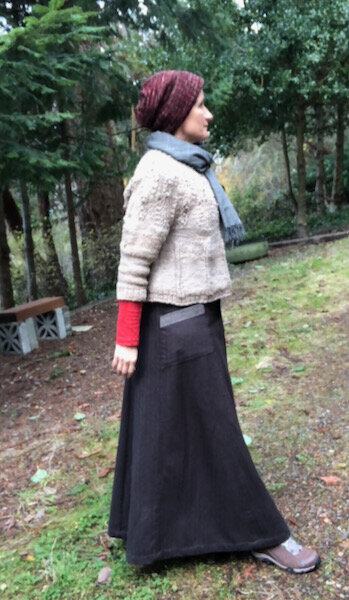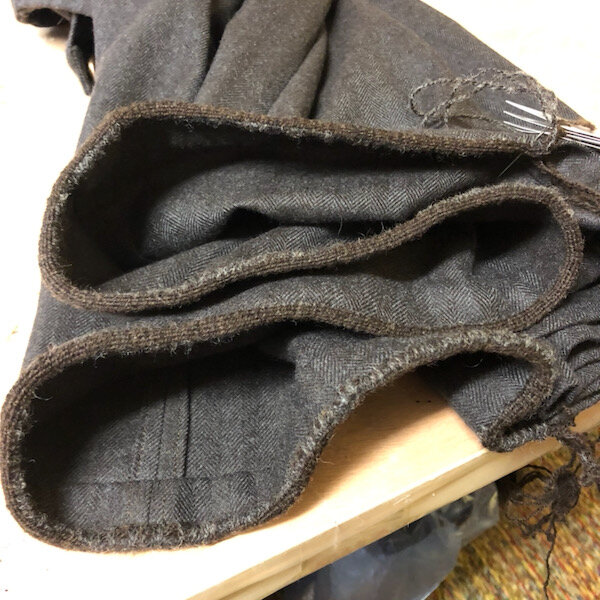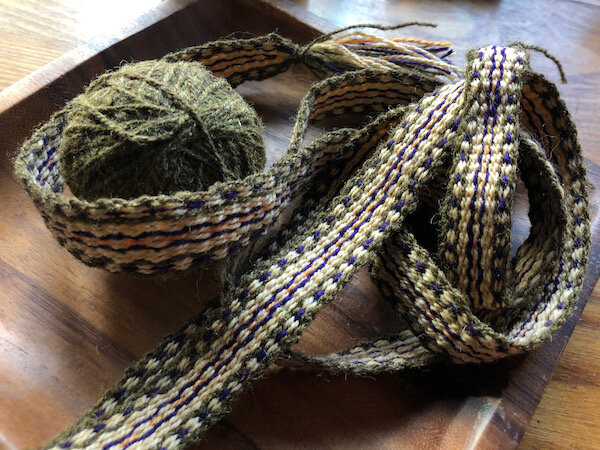I love weaving tape! Plain weave tape with warped-in design is enormously gratifying right now. It’s a way of always having weaving in progress that is simple, straightforward, and practical. It’s also a way of using handspun yarn that I may not have enough of to make something larger, but I want to see how it functions in a weaving. The tussah silk above is a good example of that - and I’m very happy with it as warp-faced tape. I feel like making a whole garment of some kind, just for the sake of using that silk tape as an edging.
Being preoccupied with weaving tape means I’m noticing garment edgings more, such as these details on Uzbek robes, again from the beautiful Susan Meller book Silk and Cotton: Textiles from the Central Asia that was. All the robes have edging, some of which is embroidered, some woven on with a “loop manipulation” technique that I’d like to research further, and some woven separately and sewn on. It makes sense, these were hard-wearing garments, meant to last through many years of daily use, and the edging protects and reinforces the most vulnerable parts of the cloth.
This is also the reason and rationale for the card-woven hem that Morgan Donner recreated, using the Medieval Garments Reconstructed book, which analyses archaeological textiles found in Greenland. And it’s why I decided to try the technique on my recently completed long wool skirt. In fact, I think weaving this edging did even more for getting me interested in exploring garment edgings, and noticing their various manifestations.
Shetland from a sheep named Kevin, Superior Fibers in Edmonds, WA. Romney lambswool from One Straw Ranch, Nordland, WA.
The skirt after sewing was finished, prior to adding woven binding. This is my winter uniform: handspun sweater, long-sleeved shirt, scarf, handknit hat, wool skirt, boots (leggings underneath.) I can put together an outfit made by me except for leggings, underpants and boots - but in this case I did not make the shirt or scarf.
The beautiful Italian wool suiting from my skirt has a deep brown warp and a charcoal grey weft, both of which were wools available in my stash (surprise, surprise!) I spun up some of the dark brown Romney lamb and the grey Shetland, both from nearby sheep farms, and got out the cards from my 2017 class with John Mallarkey, and got to it.
Card weaving in progress. The tricky part was figuring out how to hold it, to keep the shed open, tension on, stitch the weft through, etc. Hand had to learn the best method to avoid hours of awkwardness. The point nearest me is pinned to my belt, and the far end attached to a clamp on the table.
Hem view of nearly finished cardwoven binding.
This was quite the learning experience (hint: Morgan makes it look extremely easy), but so gratifying to see a sturdy, handwoven binding develop along the hem. The weight and density of it enhances the twirl factor of this skirt, giving it a liveliness as I move around, and it has become even better suited to my inclination to wear it ALL the TIME this winter.
And you know, I didn’t even realize I was going to talk about that, but it is closely related to this narrow tape weaving, and all of a piece with investigating handmade clothing and the relationship with my weaving and spinning. The other thing that made band weaving extra fun was the new release of Inkle Visualizer, a charting software application for warped-in plainweave designs (no inkle loom required, as long as you can weave warp-dominant construction.) It’s essentially a digital coloring book, making the testing out of stripe patterns very quick and entertaining. My tussah silk band motif came from my Inkle Visualizer experimentations, as did the design for the handspun wool band below.
Spindles-spun wool in heathered green, deep purple, pale orange and bright orange with warped-in design. Ball of green handspun wool.
My only regret for the ones that work well is that I did not make a longer warp. So far I haven’t done more than a couple of yards, but I’m thinking of trying some longer lengths, to store up some serious yardage for future use. The ones that aren’t long enough to use as garment edgings can always be ties for backstrap weaving, or bundling things, or as tape for making hanging tabs on dish towels, or as straps on bags…. I’m convinced they will all come in handy somehow.
My handwoven tape stash so far: six tapes, mostly cotton, one handspun wool, one handspun silk.







